Fights are not uncommon occurrences. While real canines generally decide a winner after a few rounds of bluffing, Luperci are considerably more dangerous in their confrontations, especially as weapons other than their teeth and claws become more widely used.
The Right Weapon
Size, Strength, and Body Type
Your character’s physical size, speed, strength, and many other factors collectively determine the best type of weapon.
While it’s not impossible for a small character to use a giant battle axe, they’re usually better suited to a smaller, faster weapon. Lightweight and small characters with a more athletic body type would do better with lighter weapons — projectiles, thrown weapons, as well as small melee and bladed weapons. Larger characters will benefit more from large weapons — they be able to use them more easily due to greater physical strength.
- Example: A small coyote hybrid is very quick on her feet and uses a pair of daggers. Their fighting style would probably be to move as much as possible, trying to dodge or defend as many hits from their opponent as possible.
- Example: A tall, long-armed character using a long weapon such as a bladed staff increases natural reach and can provide a key advantage.
- Example: A thick-bodied, heavyset character who does not move very quickly might benefit greatly from the use of a shield.
- Example: A generally weak character who is not at all good at the physical aspect of fighting — may use silent or very quiet projectiles, such as a throwing knife or a blow dart gun with poisoned darts. This would greatly increase their ability to sneak around and surprise attack their opponents.
Versatility
The most versatile types of weapons (and thus, the most popular) are those that can be used for both combat and hunting. For example, projectile weapons such as thrown spears or bows and arrows can greatly increase hunting success. The same cannot be said for most close-quarter weapons. Most Luperci hunt well enough with tooth and claw, enough so that wandering around with a sword to kill a deer seems kind of silly, huh?
Maintenance
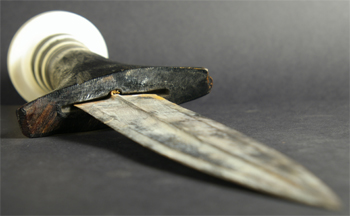
Weapon maintenance is a concern in determining which is appropriate for your character. Failure to maintain weaponry can result in, at worst, grievous injury or, at best, weapon malfunction and loss of a fight or hunting opportunity.
The lowest-maintenance weapons are blunted close-quarter weapons (e.g., bats and clubs). They generally do not require maintenance other than perhaps cleaning. On the contrary, a weapon with moving parts (e.g., crossbows and catapults) would require constant maintenance. Even blades, seemingly simple weapons, require sharpening with a whetstone. Still other types of weapons require ammunition: e.g., making arrows.
Obtaining a Weapon
There are two primary ways to obtain a weapon.
- Trading with another character.
It may not be difficult to find trader offering a bow and arrows; however, trading for a seventeenth century antique Japanese katana in decent condition is going to be much more difficult (both in terms of finding a trader with this item and in terms of actually having enough trade value — such items are ridiculously valuable (in terms of trade) to Luperci!). - Crafting a weapon or finding a craftsman.
Metalworking is a complex trade and requires a variety of advanced tools and raw materials in addition to advanced knowledge — most characters are better off making simpler items. However, there are a number of rudimentary weapon techniques available to Luperci: sharp arrowheads can be made of bone or stone, spears and clubs are easy to make.
Thirty years into a post-human world, it is highly unlikely for human-made weapons to be found just lying around. Most places have long since been rooted through and pilfered of all usable items, including anything resembling a weapon. Medieval-era weapons weren’t all that common to begin with, anyway.
Weapon Types
Defensive Weaponry
Fortification and Territory Defense
Ditches, fences, barbed wire, palisades, stockades, gates, walls, small moats (water-filled ditches), tall outposts for archers (e.g., tree stands or windows of relatively tall buildings), murder-holes (windows and holes in walls or other high perches from which heated material, especially oil, can be dumped), and many other forms of territorial defense can be employed. Naturally, peaceful packs and peaceful areas do not partake in these fortifications; they are more commonly found in conflict-ridden areas.
Traps
Traps are excellent defensive weapons. Widely utilized by Luperci — especially in the more advanced parts of the world — traps defend territory and capture prey. Traps may be very simple — e.g., a hidden pit — or they may be rather complex (e.g., a pit with spikes and a collapsing metal sheet to cover the hole). Snare traps are amongst the most common Luperci hunting traps — they are especially advantageous for traveling Luperci, who can set them overnight to catch the next day’s food as they rest.
Armor
Some characters may be interested in armor to protect themselves from weapon-wielding enemies. Armor is largely impractical in most situations: its weight and disadvantage to speed and agility make it a poor choice except against unarmed foes. Luperci are generally not able to wear gear crafted for people. Most are too small and too tight, even if it were found in usable condition.
Armor can be crafted from leather and custom-made to fit a particular Luperci. Metalworked armor is generally not possible for Luperci excepting very simplistic plates (e.g., a chest plate supported by leather). Gauntlets and greaves able to move with a Luperci’s foot motion are too complicated for even advanced metalworkers to craft.
Allowed Weapons
Blunt Weapons
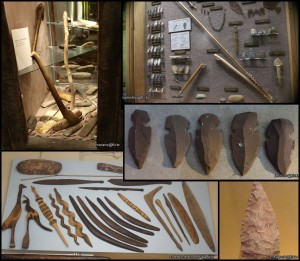
- Examples
Bats, clubs, maces, and flails. - Use
Blunt weapons rely mostly on mass and raw impact energy to disable opponents through broken bones, internal trauma or concussions. Generally they are used in simple swinging motions. Although they can be used for hunting, most are far from ideal due to the short range required to use them. - Advantages
Blunt weapons can be very effective even in one good strike: e.g., a shot to the head or a glancing blow that shatters or damages a shoulder. Blunt melee weapons are more effective against armored opponents than many other weapon types. Armor, especially the types commonplace for Luperci, is ineffective at preventing blunt trauma. - Disadvantages
Blunt weapons are usually heavy, as the extra weight is needed to cause greater damage. This often makes blunt weapons both strenuous to wield and difficult to maneuver. - Obtaining and Maintaining
Blunt melee weapons are among the easiest to maintain and find — it doesn’t take much for your character to carve a crude yet effective bat from a thick tree branch.
Bladed Weapons
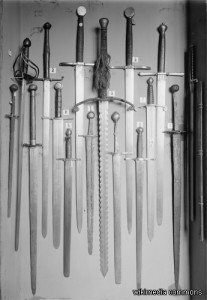
- Examples
Examples of bladed melee weapons include swords, spears, axes, daggers, knives, and so forth. - Use
Edged weapons work by concentrating the pressure of a swing into an edge or point. When fighting with an edged weapon, canines seek to lacerate or puncture and stab. Hunting with a short-range, close-quarters bladed weapon can easily be more dangerous than hunting unarmed for the inexperienced hunter; on the contrary, ranged weapons (e.g., a thrusting spear) can make taking down large prey easier. - Advantages
When wielded by an experienced user, bladed weapons can easily be more dangerous than Luperci claws alone — they can penetrate deeper and create larger lacerations. Additionally, they are more widely useful than a blunted weapon (e.g., a knife can be used for skinning and defending/attacking). - Disadvantages
Blades are largely ineffective against many times of armor (e.g., a metal plate or a thick, boiled leather gauntlet). An inexperienced Luperci is almost always better off using tooth and claw, whether hunting or fighting. - Obtaining and Maintaining
Most bladed melee weapons are not very difficult to come by in and around Halifax — though of course, the range varies from common “standard kitchen knife” to far rarer “military grade combat knife.” Bladed melee weapons require maintenance such as sharpening, which require whetstone or similar.
Thrown Weapons
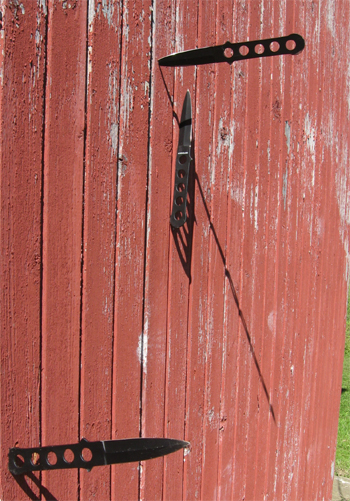
- Examples
Examples include darts, bolas, tomahawks, throwing spears, and throwing knives (specially balanced knives intended for projectile use). - Use
Thrown weapons rely on the force of the user’s throw as well as their accuracy. Advantageous toward hunting, throwing weapons are small and lightweight, and as they can be used from a distance. - Advantages
Thrown weapons increase a character’s natural range of attack. They are excellent for keeping quiet and retaining the element of surprise. - Disadvantages
A character with poor hand-eye coordination would not do well with thrown weapons. Many thrown weapons are reduced in efficacy when the target is wearing armor, even strengthened leather (in the case of some small knives and darts). - Obtaining and Maintaining
Different thrown weapons require different maintenance. Some weapons degrade naturally with use — wood-handled spears, for example, wouldn’t last very long if used often. The wooden handles would eventually have to be replaced, though the heads (if sharpened) could be recycled. Tomahawks and throwing knives would require sharpening, depending on their material.
Projectile Weapons
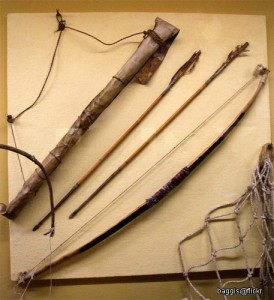
- Examples
There are a few projectile-type weapons still left in the ‘Souls universe — bows have been around for quite some time, and even wooden, slow-reloading crossbows can made. Slings have historically been used for hunting, and they existed with humanity for some time — this is a technology accessible to Luperci. Blowguns are another option, and even rudimentary catapults. - Use
Projectile weapons have a variety of uses, from territorial defense to hunting to offensive attacking. They are among the most versatile of weapons. - Advantages
Range is greatly increased when using a projectile, of course — even more so than thrown weapons. Similar to thrown weapons, they are excellent for sneaky characters in some cases — not so much in others (e.g., huge and noisy catapults, noisy crossbows). - Disadvantages
Many projectile weapons become essentially useless at close range. An added drawback of projectile-firing weapons is that most of them require ammunition, even the low-tech sling. Though any stone can be used in a pinch, sling stones that are either selected from a prime spot (generally a river) or crafted are much more accurate and easier to use. Crossbows and regular bows both require arrows, and blowguns require darts. Catapults would require larger stones or even more complex ammunition, thus their rarity. - Obtaining and Maintaining
Projectile weapons are typically high maintenance — crossbows, bows, blowguns, and catapults all require general maintenance and upkeep. Slings are relatively easy to make and maintain. Bowstrings must be re-strung, blowguns must be cleaned. Crossbows and catapults have moving parts and are among the most difficult items for Luperci to maintain, create, or restore. Many of these weapons were not common in human times. Few working replicas of ancient crossbows/catapults are available; meanwhile, even modern fiberglass or synthetic crossbows have likely degraded beyond the point of use.
Rare and Esoteric Weapons
In some cases, very basic chemical weapons can be made by Luperci. These primitive analogs generally rely on interfering with the physical body (e.g., breathing, vision). These agents would not be nearly as powerful as their human counterparts. Additionally, their effectiveness is limited, as Luperci cannot A) create a direct, accurate “spray” of these items or B) disperse these items over a wide area with guaranteed accuracy.
- Instead of mace or pepper spray, a Luperci could instead dry out hot chili peppers to create a powder. This powder could then be thrown or released over enemies.
- A warring Luperci pack might choose to light a large bonfire upwind of a neighboring pack, stoking it with plastics, chemicals, plants, and other noxious-burning items to create choking smoke. This is, of course, subject to changes in the wind and quite dangerous (e.g., explosive items!).
Disallowed Weapons
Working weapons the following types are NOT permitted in-game, in character histories, etc.
Firearms
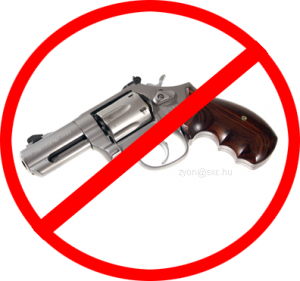
Firearms require far too much maintenance and restoration: working-condition firearms cannot be found or made in the ‘Souls universe. Not only are guns incredibly complex to maintain, ammunition provides a challenge. Characters are permitted to obtain and keep firearms, but working specimens are prohibited.
Advanced Weaponry and Heavy Ordnance
Most advanced weaponry and heavy ordnance would not be usable to Luperci. These items would have degraded beyond use or quickly overrun by humanity in their last days. Heavy ordnance — artillery, rocket launchers, grenades, mines, and anything else that might explode — is simply not allowed. The same can be said for any electric, magnetized, laser, nuclear, or any other advanced weapon types.
Biological weapons are beyond the scope of Luperci’s scientific knowledge, as well as any weapons created from synthesized chemicals — e.g., true mace or pepper spray as opposed to the aforementioned natural analog, mustard gas, etc.